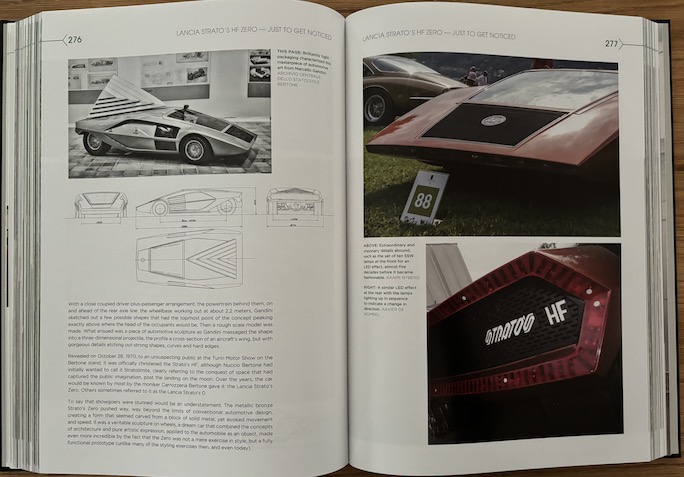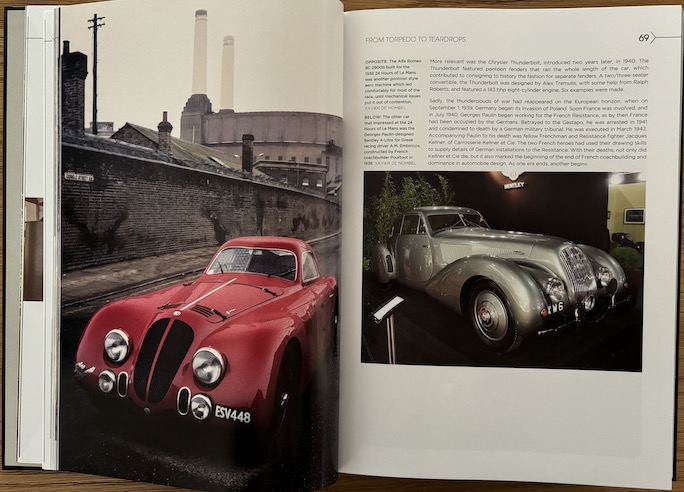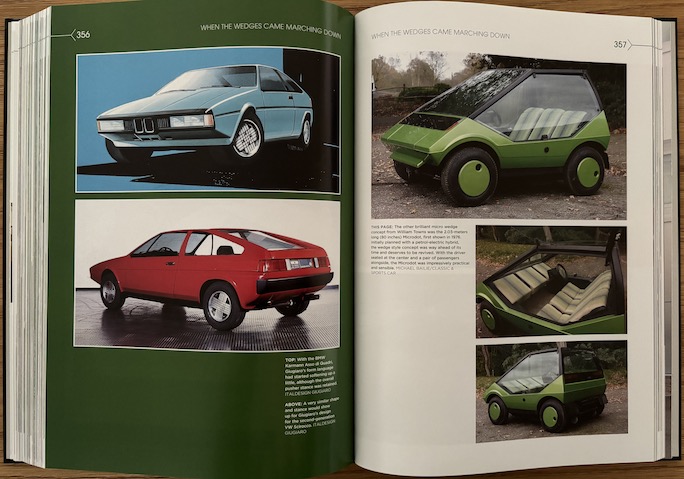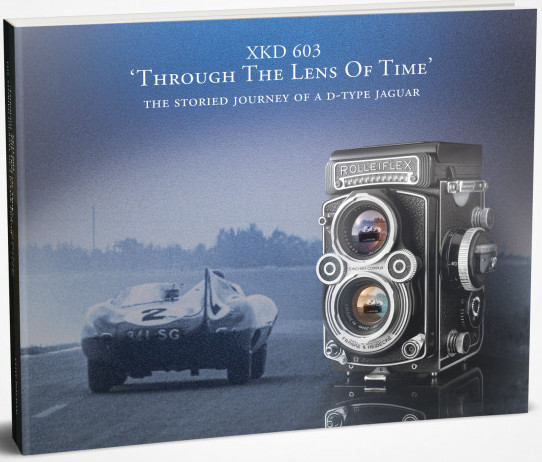When Wedge had the Edge
 by Gautam Sen
by Gautam Sen
“Plus, Oyono also points out that, ‘a triangular shaped vehicle, read from nose to tail with a fairly or strict sharp angled form language, bearing an overhang generally longer at the front than the rear is a wedge. In other words, the median line ascending from nose to tail should be read clearly with the human eye and not necessarily at YO.’ (Incidentally, YO is the two-dimensional profile of the vehicle’s shape, and thus refers to all the Z-points @ OX, in other words, along the Y-axis.)”
Having fun yet? Well, you will, because that particular excerpt is about as abstract as the book gets.
Still, unless car design is your daily bread, there is much, very much in this book that will strain the ole noggin. Pusher, puller, inverted blimp, should the pointy end be in the front or the rear or both . . . exactly what combination of factors and effects make a wedge a wedge?

The cover car, the quintessential wedge, Bertone’s “iridescent green arrowhead.”
It may not take you three months to read but would you believe it took the author only three months to write this 480-page behemoth? And just look at that oh so clever book title, and the smart page design and typography—lesser mortals would have taken three months just to think that up.

Given that this whole book was conceived in a hurry it is nothing short of remarkable how quick the designer came up with a look that suits the subject so well. Even the page and chapter numbers are cleverly styled.
Author Gautam Sen obviously didn’t come at this cold but was able to draw on decades of immersion into the subject, having written an intimidatingly tall stack of weighty car design books. Even if wedge design and its 1970s heyday isn’t top of mind for you, it’s hard to imagine anyone not finding something new and relevant in this authoritative survey because it embeds that particular design trend into the overall history of automobility. In fact it is not until half-way through the book that the cleverly titled chapter (6 of 20) “Yet to Get to the Edge” begins to zero in on car designs anyone alive now could have seen—and had a reaction to, often enough dismissing such ideas as wildly impractical and esthetically dubious. Are you thinking Lamborghini Countach now? It may have ended up on countless bedroom walls but it wasn’t the first, of the modern era, and definitely not the most radical. This book sorts it all out.

It’s only 1902 and already the tinkerers tinker with shapes. These contraptions attained alarming speeds, won races, set records. Ah, progress.
If you attended the 2024 Pebble Beach Concours you would have noted that there were two classes of wedge-style concept cars and prototypes, in a display rightly called history-making. And it was Sen who had been commissioned to write an article for the summer edition of the concours’ Insider magazine. But condensing his encyclopedic knowledge into eight paltry pages, and realizing that a concours is going to be selective, he figured a properly thorough book was the way to do the topic justice, never mind that such a book would have to be written and laid out and printed in the few months remaining between the concours magazine and the actual concours. That a publisher and a book designer were willing and able to interrupt what they were doing . . . what are the odds? And mind you, this book is missing nothing—bibliography, index, a smart foreword. Check.

You’ve heard of the Lancia Stratos but do you spell it Strato’s, as this book does, from the Table of Contents to the Index? Hark!, you say. A typo—a silly one—a whopper—he-heh. Well, right back atcha. Look at the bottom right photo; the spelling is derived from strato’sfera, Italian for stratosphere, the limits of which this 1970 Lancia is aiming for, which is why it was supposed to be called Stratolimite. Sen’s next book will be about just that car: Lancia Stratos HF Zero: The Eternal Futurist (ISBN 978-1956309201, same publisher). Yes, yes, the new book does not have the apostrophe—because there’s no point tilting at windmills.
For the sake of context, the book proper begins with “A Short History of Auto Design,” i.e. the earliest of early cars. Basically motorized, self-propelled versions of the horse-drawn carriage, they retained many of the old styling cues until the ever-increasing achievable speed was found to be hampered by the boxy packaging of mechanical systems and also occupants: sleeker coachwork was needed.

The book mentions very many cars, especially in the early, general-history part. Often, you will wish for a photo—and chances are there is one, but probably several pages later because there are so many illustrations that they just cannot fit right where the text first refers to them. For instance, the splendidly large photo of the Alfa (l) comes 11 pages after the text first talks about it.
And so it begins—torpedoes, teardrops, tailfins, kamm tails, front/rear/mid-engine, cab-forward. You’ll be surprised how many more dots there are to connect aside from big-name automakers and obscure innovators. And Sen doesn’t even include all the fringe cars/designs, both because of the accelerated publishing schedule and because the book is already almost 500 pages long. Sen follows the story to the present day—think Tesla Cybertruck—and the take-away is: the wedge is back, as he writes, with a Wengeance!

Copyright 2024, Sabu Advani (speedreaders.info).


 RSS Feed - Comments
RSS Feed - Comments






































































 Phone / Mail / Email
Phone / Mail / Email RSS Feed
RSS Feed Facebook
Facebook Twitter
Twitter